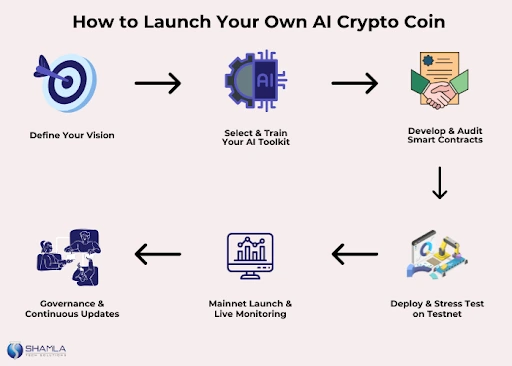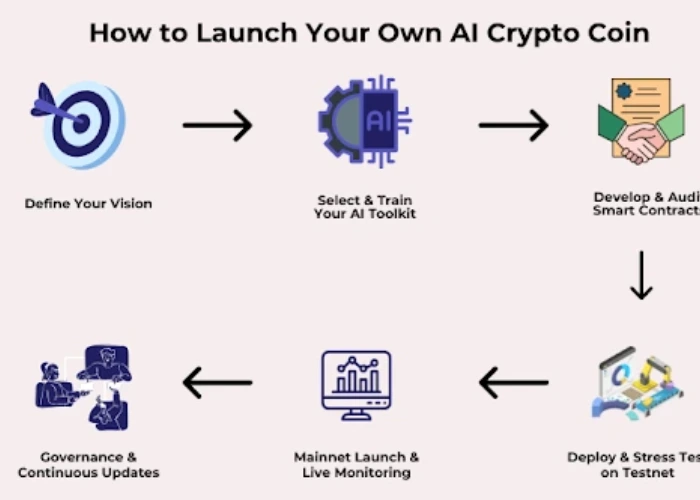The integration of AI in blockchain is changing the way we actually handle cryptocurrencies. If you want to launch your own AI crypto coin, understanding how AI can drastically improve blockchain technology is absolutely crucial. AI helps streamline transaction processing, improve security, and make decision-making smarter and faster in blockchain systems.
While AI didn’t create blockchain, it definitely plays a major role in advancing it. By using AI in crypto, you can optimize mining, increase efficiency, and build better algorithms for predicting market trends. When you launch your own AI crypto coin, it allows you to combine the best of both technologies, offering future-proof solutions for investors.
6 Easy Steps to Launch Your Own AI Crypto Coin
Define Your Vision
Set clear goals for your token’s functions, AI features, and user roles. Define token rules, supply limits, and governance paths. Outline data sources and performance targets to guide the development phase.
Select & Train Your AI
Pick an ML library like TensorFlow or PyTorch. Connect live price or network feeds. Ingest data using oracles. Clean, normalize records. Train models on historical chain events for pattern detection.
Develop & Audit Smart Contracts
Write smart contracts in Solidity or Move. Embed AI calls for token minting and supply adjustments. Use static analysis and fuzz tests. Fix errors, harden logic, then verify bytecode security.
Deploy & Stress Test on Testnet
Deploy contracts to a private testnet. Feed simulated or live-style data via nodes. Run load tests at peak transaction rates. Monitor gas costs, block times, and model responses under stress.
Mainnet Launch & Live Monitoring
Launch on mainnet with live oracles and validator nodes. Track metrics like TPS, wallet interactions, and AI signal accuracy. Adjust AI thresholds and token rules based on real-time performance logs.
Governance & Continuous Updates
Release periodic AI model updates via decentralized governance. Collect on-chain vote data. Patch smart contracts through upgrade patterns. Replay security audits and regression tests. Improve detection rules and user features.
How Can AI Help in Blockchain Technology?
Integrating AI helps blockchain by speeding tasks, boosting safety, and improving data checks. If you plan to launch your own AI crypto coin, use AI in these key areas:
Key Improvements:
- Fraud Detection: AI spots fake transactions before they reach the chain.
- Smart Contract Testing: AI checks code for bugs and weak spots.
- Mining Control: AI tunes hardware settings to cut power waste.
- Trend Analysis: AI finds price shifts by scanning large data sets.
- Consensus Tuning: AI adapts validator schedules to reduce delays.
AI Function | Value |
Fraud Detection | Blocks invalid or risky transfers |
Smart Contract Tests | Catches errors and weak spots in code |
Mining Optimization | Lowers energy use and boosts hash throughput |
Trend Monitoring | Predicts market moves for better timing |
Consensus Scheduling | Keeps block times steady and network smooth |
By using AI for transaction checks, consensus tuning, and network scans, you build a faster, more secure chain. Developers often check the top 10 artificial intelligence AI crypto coins for benchmarks before they invest time. AI models can flag unusual blocks, detect network attacks, and speed up block creation.
To launch your own AI crypto coin with clear steps, start by choosing an AI toolkit and training it on real network data. Next, set up secure data feeds and simulate loads on a private testnet. Then deploy smart contracts, monitor real-time metrics, and fine-tune your AI rules continuously. Regular updates based on live feedback will keep your AI coin adaptive and efficient. Launch your AI crypto coin confidently by following these focused, practical actions.

Can I Create My Own AI Agent in Cryptocurrency?
You can build an AI agent that reads blockchain data, learns from patterns, and acts on your behalf. If you want to launch your own AI crypto coin, embedding an AI agent lets your token adapt to market moves and user behavior automatically.
Core Steps:
- Data Ingestion: Connect to on-chain oracles for price feeds and network stats.
- Model Training: Use basic machine-learning libraries to identify trends in historical blocks.
- Smart Contract Integration: Deploy simple contracts that call your AI agent for trade execution or governance votes.
- Node Access: Run a full node or use a light client API to push transactions.
- Monitoring & Alerts: Set up dashboards for real-time agent actions and failure notifications.
Module | Role | Example Tools |
Oracle Connector | Feeds live price and volume data | Chainlink, Band Protocol |
ML Engine | Learns patterns and signals | TensorFlow Lite, PyTorch |
Contract Interface | Executes calls on the blockchain | Web3.js, ethers.js |
Node/API Layer | Submits and confirms transactions | Infura, Alchemy |
Dashboard & Alerts | Tracks agent decisions and issues | Grafana, Prometheus |
After you build your own AI crypto coin, test your agent on a private testnet to validate safe execution. Next, simulate high-traffic loads and error cases to ensure stability. Finally, deploy on mainnet and fine-tune AI thresholds based on live feedback.
By following these clear actions, you’re ready to launch your own AI crypto coin with an embedded AI agent that boosts security, efficiency, and adaptability.
Did Artificial Intelligence Create Blockchain?
Blockchain began with Satoshi Nakamoto’s 2008 Bitcoin whitepaper. AI did not create blockchain, but today AI boosts chain functions. If you launch your own AI crypto coin, you leverage AI’s fast data checks on a secure ledger.
Origins vs. AI Development:
- Blockchain Birth: Bitcoin ledger started without AI.
- AI Arrival: Machine learning tools entered chains post-2015.
- Merged Tech: Since 2021, projects use AI for fraud checks and contract tests.
Year | Chain Event | AI Contribution |
2008 | Bitcoin whitepaper published | None |
2015 | Ethereum launches smart contracts | Early AI for code analysis |
2021 | First AI-powered DeFi tokens appear | AI agents manage risk and trades |
2024 | Proposals for AI-native blockchains | AI-driven consensus tuning |
AI now tests smart contracts, spots fake transfers, and speeds up block times. To create your own AI crypto coin, you train simple models on on-chain data and connect them via oracles.
Key Steps to Launch Your Own AI Crypto Coin:
- Collect Data: Use oracles for live price and network stats.
- Train Model: Build a small ML system to flag anomalies.
- Deploy Contracts: Write contracts that call AI signals for trades or votes.
- Test Thoroughly: Run on a private testnet with real data feeds.
By understanding that AI didn’t build the first chain but now powers key functions, you can launch your own AI crypto coin with practical, clear actions.
What Is the Role of AI in Crypto?
AI acts as a smart layer that reads blockchain data, finds patterns, and makes key decisions automatically. When you launch your own AI crypto coin, AI helps you:
- Data Analysis: Scan large ledgers for trends and outlier blocks.
- Risk Control: Spot fraud or hacks by checking transaction history.
- Price Signals: Predict token moves from market feeds.
- Contract Security: Test smart contract code for flaws.
- Consensus Tuning: Auto-adjust block times and validator sets for smooth operation.
AI Role | Value | Example Tools |
Data Analysis | Finds trading patterns and network gaps | Python Pandas, SQL |
Risk Control | Blocks fake transactions before inclusion | Scikit-Learn, Isolation Forest |
Price Signals | Gives buy/sell triggers | TensorFlow Lite, Prophet |
Contract Security | Checks code for bugs | MythX, Slither |
Consensus Tuning | Keeps blocks on time, cuts delays | Reinforcement Learning Lib |
To start your own AI crypto coin, first collect real-time chain data via oracles. Next, train simple machine-learning models for key tasks like fraud detection. Then integrate AI calls into your smart contracts so they trigger actions, such as pausing trades or auto-rebalancing. Finally, test on a private network, monitor AI logs, and refine signal thresholds.
By embedding AI, you cut manual checks, boost network safety, and speed up operations. If you plan to launch your own AI crypto coin, focus on clear data pipelines, modular AI services, and tight security audits. With these steps, AI becomes your coin’s backbone, driving smarter, faster, and more secure blockchain functions.
Should I Invest in Blockchain or AI Development?
Choosing between blockchain and AI development depends on your goals and timeline. If you want quick wins in secure ledgers, blockchain offers clear use cases. If you aim to automate insights and predictions, AI has broader reach. To launch your own AI crypto coin, you need both: blockchain for trust and AI for smart features.
Key Factors to Consider:
- Market Maturity: Blockchain projects still face scaling and regulation hurdles. AI tools are widely adopted across industries.
- Skill Requirements: Blockchain demands deep consensus and cryptography knowledge. AI needs data science and model training expertise.
- Initial Costs: Setting up nodes and smart contracts can be costly. Training large AI models also incurs high compute bills.
- Revenue Streams: Blockchain earns via transaction fees and token launches. AI can monetize through API access and licensing.
- Time to Market: Deploying a simple smart contract takes weeks. Building a robust AI pipeline may take months.
Criterion | Blockchain | AI Development |
Market Readiness | Emerging, facing regulation | Established, high demand |
Technical Barrier | Consensus, wallets, smart contracts | Data pipelines, model training |
Cost Drivers | Node infrastructure, audits | GPUs, cloud compute |
Revenue Model | Fees, token sales | Subscription, licensing |
Launch Timeline | Weeks to months | Months to over a year |
If you plan to launch your own AI crypto coin, factor both ecosystems’ costs and timelines. To help your vision of “building my own AI crypto coin”, start by prototyping with open-source AI frameworks and testnets. Balance your budget: allocate part to secure blockchain audits and part to AI model tuning. By blending both, you maximize technical edge and market fit, setting you up to launch your own AI crypto coin that stands out.
What Is the Relationship Between Blockchain and AI?
Blockchain and AI work together to deliver secure, smart systems. If you launch your own AI crypto coin, you combine unchangeable data storage with fast data insights.
Core Synergies:
- Data Integrity: Blockchain stores records in linked blocks. AI uses this accurate data for better predictions.
- Smart Contracts: AI checks and updates contract logic based on live inputs.
- Predictive Analysis: AI scans on-chain metrics to forecast network load and token value.
- Automation: AI bots execute trades or governance votes via blockchain calls.
- Identity & Privacy: AI manages user IDs, while blockchain secures them without a central server.
Feature | Blockchain Role | AI Role |
Data Integrity | Immutable ledger | Cleans and feeds data into models |
Contract Logic | Executes code when conditions match | Tunes conditions using live data |
Forecasting | Provides on-chain metrics | Predicts trends from metrics |
Automated Actions | Records each action on the chain | Decides actions from algorithm rules |
Privacy Management | Offers pseudonymity | Controls access with smart filters |
To develop my own AI crypto coin, start by linking an AI model to chain oracles for price and usage feeds. Next, embed AI triggers in smart contracts to adjust token rules automatically. You then test on a private network, tune AI decisions based on logs, and audit both code and model. When you launch your own AI crypto coin, this tight link ensures tokens adapt quickly and run with full traceability and safety.
Would Cryptocurrencies Like Bitcoin and Ethereum Be a Part of AI's Future?
AI models need fast, reliable data sources. Bitcoin and Ethereum offer large, public ledgers that feed AI signals. To understand an AI agent in crypto and how does it work: the agent reads block data, spots patterns, and triggers actions on-chain.
Key Roles for Bitcoin & Ethereum:
- Data Feeds: Both chains supply price and volume history for AI training.
- Governance Signals: AI can assess on-chain votes and suggest protocol changes.
- Automated Trading: Bots execute buy/sell orders based on live block events.
- Identity Verification: AI checks user behavior, blockchain confirms history.
- Resource Allocation: AI directs gas fees or mining power to keep the network smooth.
Feature | Bitcoin Role | Ethereum Role |
Data Feeds | Price, hash rate | Token transfers, contract calls |
Governance | Limited (hard forks) | On-chain voting via smart contracts |
Trading Automation | OTC bots using off-chain tools | DeFi bots running on-chain orders |
Identity Checks | Wallet history only | Wallet + contract interaction logs |
Resource Management | Adjust mining difficulty | Gas fee optimization via EIP tools |
As AI grows, these chains become testbeds for new models. If you plan to launch your own AI crypto coin, study how Bitcoin secures data and how Ethereum runs smart logic. By blending reliable ledgers with AI insights, future coins will adapt in real time, stay secure, and offer smarter services.
What Impact Will Generative AI Have on Bitcoin?
Generative AI models that create text, code, and data will reshape Bitcoin’s ecosystem by automating tasks, boosting insights, and introducing new risks. If you launch your own AI crypto coin, study these shifts to stay ahead.
Key Impacts:
- Market Signals: AI generates trading patterns from order-book snapshots, offering fresh buy/sell triggers.
- Code Generation: Auto-write Bitcoin Script templates for multisig wallets or time-lock contracts.
- Miner Tuning: Produce optimized hardware settings to cut power use and raise hash rates.
- Risk Simulation: Auto-create attack scenarios—like fee-spike or spam floods—to test network resilience.
- Phishing Detection: Generate synthetic phishing samples, train filters, and block scam links faster.
Area | Value | Example Tools |
Market Signals | Fresh, data-driven trade triggers | GPT-4, Llama-3 |
Script Generation | Ready-to-deploy Bitcoin Script code blocks | Copilot, ChatGPT Code |
Miner Tuning | Energy cuts and hash rate gains | Custom RL agents |
Risk Simulation | Automated stress tests for mempool and nodes | SimPy, AnyLogic |
Phishing Filters | Better scam URL and transaction detection | FastText, BERT variants |
Generative AI also speeds up wallet-app docs, auto-write SDK examples, and craft on-chain analysis reports. However, attackers can use the same tools to craft fake alerts or harmful scripts. To guard against this, integrate AI-based scanners at node entry points.
By understanding these shifts, you can design robust AI rules when you launch your own AI crypto coin, ensuring your token benefits from faster insights, tighter security, and automated operations while keeping risks in check.
What Is the Purpose of Using Blockchain and AI in Web3?
Web3 aims to give users control over data, services, and value. Combining blockchain and AI in Web3 delivers secure, smart, and user-centric platforms. If you plan to launch your own AI crypto coin, this blend is key.
Core Purposes:
- Decentralized Security: Blockchain locks records in unchangeable blocks. AI scans those blocks for unusual patterns.
- Smart Automation: AI bots trigger actions (like payments or swaps) when on-chain events occur.
- Trustless Governance: AI analyzes votes on proposals; blockchain enforces the outcome without a central admin.
- Personalized Services: AI tailors UX and recommendations; blockchain protects user data without sharing it.
- Scalable Networks: AI forecasts network load and suggests shard or layer-2 scaling.
Purpose | Blockchain Role | AI Role | Example Tool |
Security | Immutable ledger | Real-time anomaly detection | Isolation Forest |
Automation | Executes smart contracts | Triggers actions from signals | TensorFlow Lite |
Governance | Records on-chain votes | Scores proposal impact | Scikit-Learn |
Personalization | Protects user IDs and history | Generates custom UI flows | PyTorch |
Scalability Planning | Enables layer-2 rollups and sharding | Predicts transaction spikes | Prophet |
By uniting blockchain’s tamper-proof data with AI’s fast insight, Web3 apps run safer, smarter, and more user-friendly. Developers set up oracles to feed AI live chain data, deploy hybrid contracts that call AI functions, then test on secure nets before going live. This clear path shows how teams can build next-gen platforms, and how you can launch your own AI crypto coin with strong Web3 foundations.
How Is Shamla Tech Best for Launching an AI Crypto Coin?
Shamla Tech is a top AI coin development company offering AI crypto coin development services. We write and deploy smart contracts on blockchain testnets, then audit and secure the code. Our AI modules watch transaction streams in real time and adjust token supply to keep price stable. We build machine-learning models that analyze market trends and trigger buy or sell orders automatically.
We run validator nodes on dedicated servers for fast block confirmation. We integrate on-chain voting tools so users make token decisions based on AI-driven risk scores. Shamla Tech handles design, coding, testing, security audits, and full end-to-end launch of your AI crypto coin.




